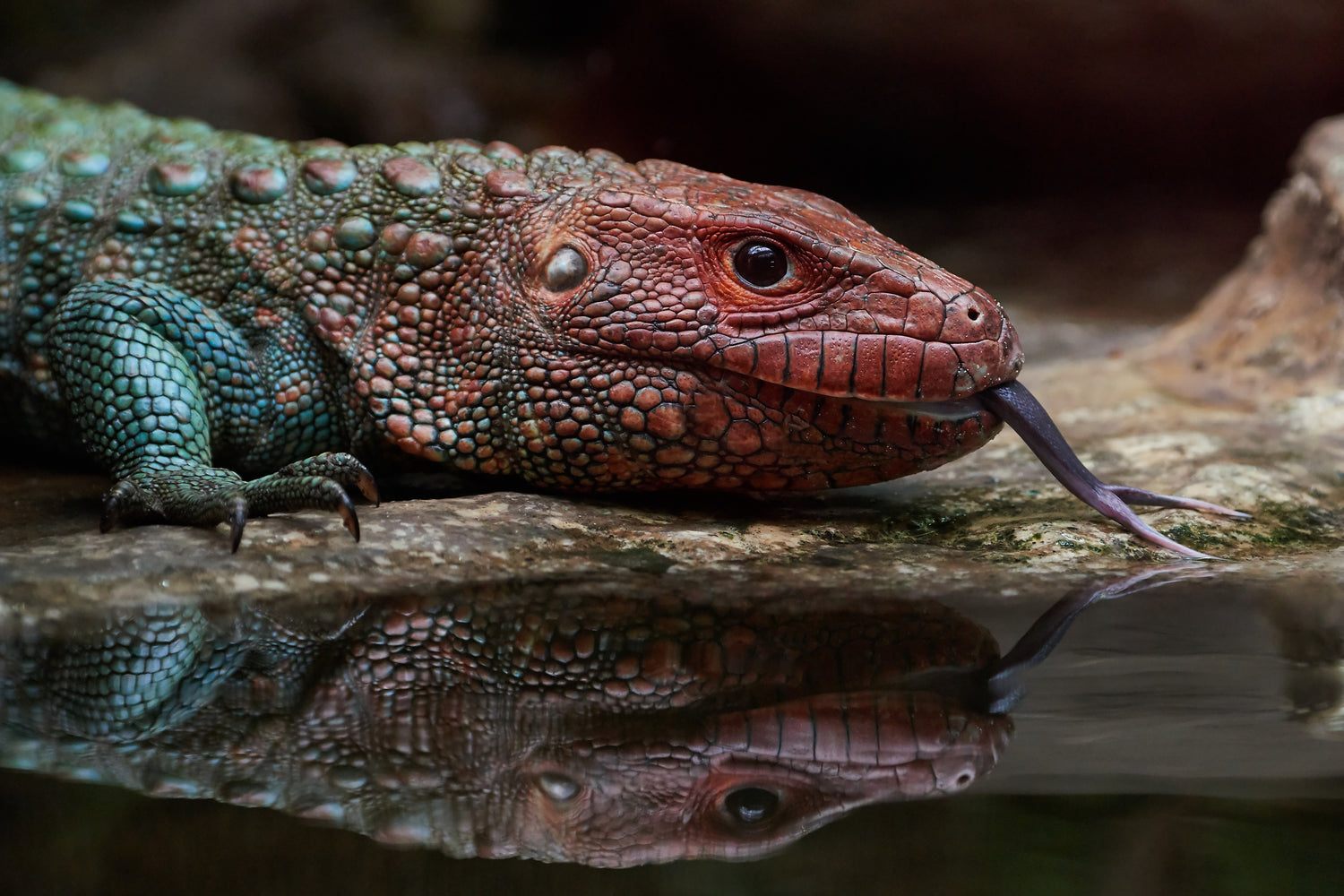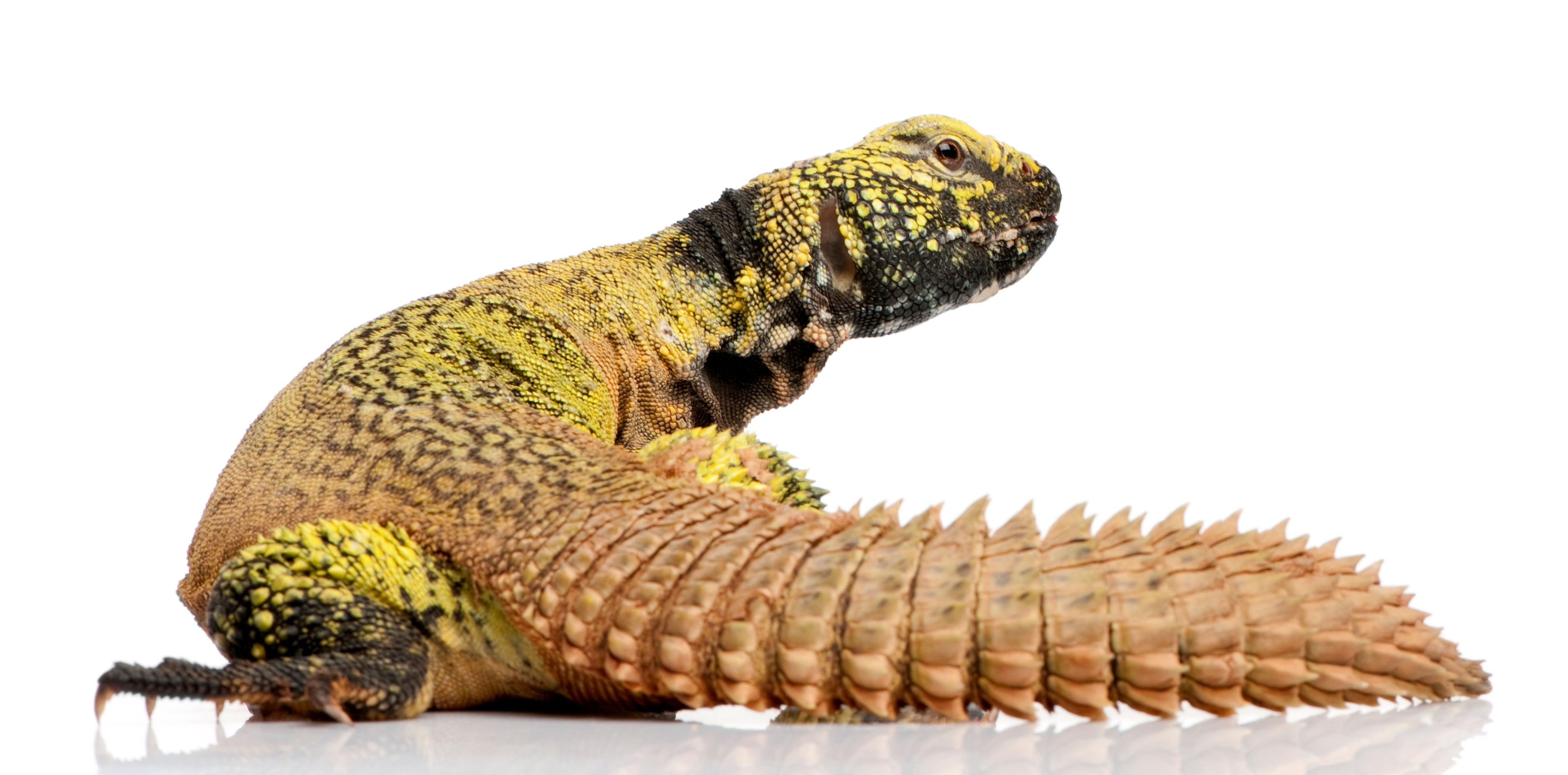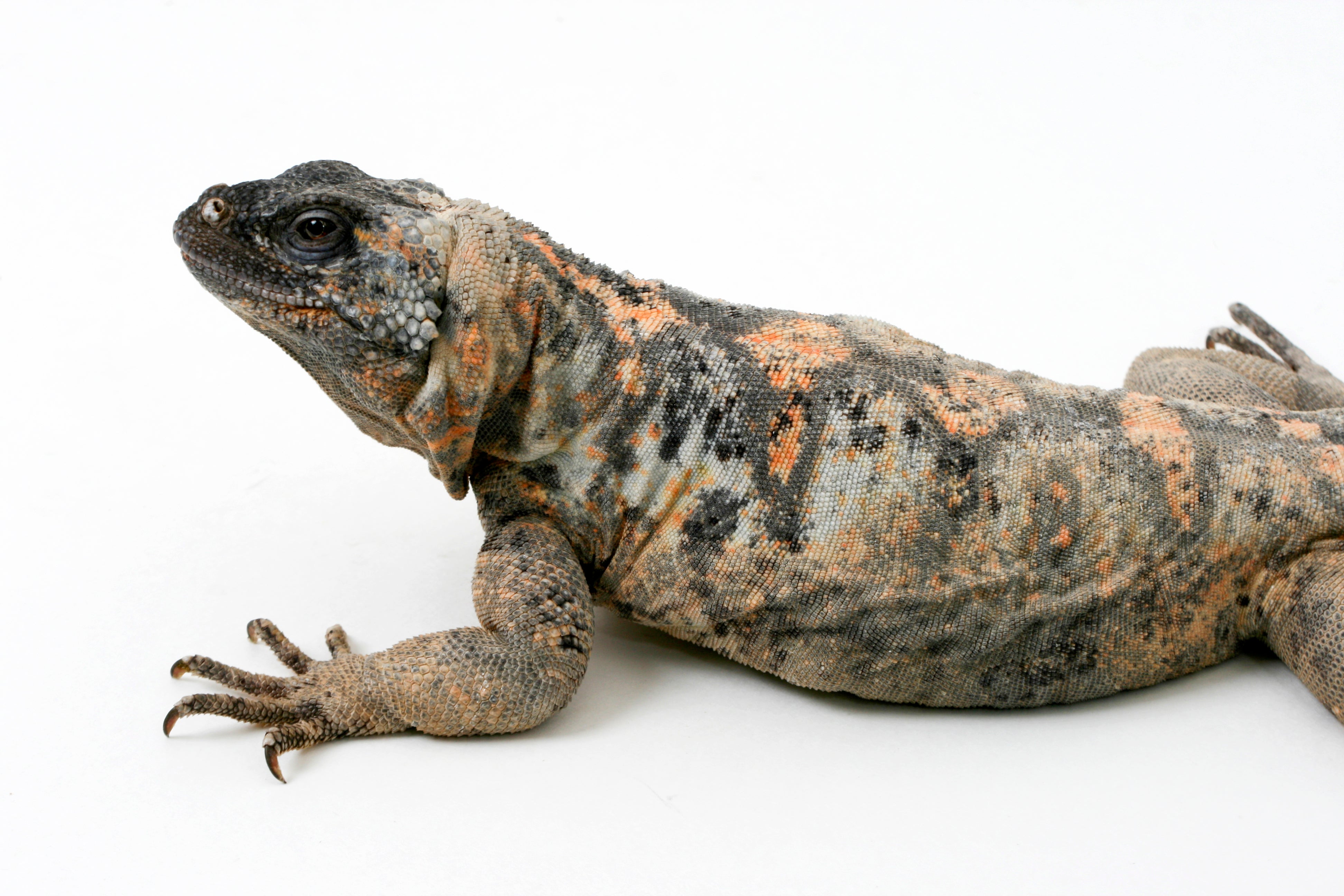Caiman lizards (Dracaena spp.) are large, diurnal, semi-aquatic lizards native to South America. They prefer a tropical rainforest habitat, and can be found in swamps, marshes, flooded woodlands, and near streams. Adults average about 4’ long, but some males are known to grow up to 5’. With good care, these lizards can live 10+ years.
Caiman lizards’ coloring varies depending on the species. Dracaena guianensis has a green body and a reddish-orange head, while Dracaena paraguayensis tends to be more of a uniform olive or brown color. Both have a blunt triangular head, prominent brow ridges, a stout body and limbs, bumpy skin, a laterally-flattened tail, and long toes with sharp claws. Their crocodilian appearance is how they earned their common name.
Caiman lizards are not very common in the hobby, which is for the best considering that they are large and generally difficult to keep, as they are very sensitive to poor husbandry. Although they are often advertised as being intelligent and fairly tame, each individual has its own personality, and some tolerate humans better than others. This is a pet that requires a lot of preparation and effort, but some would argue that makes it all the more rewarding.
How much space do caiman lizards need?
Because they are large, semi-aquatic, and spend a significant amount of time climbing, a single caiman lizard should be housed in no smaller than a 8’L x 4’W x 6’H enclosure. If at all possible, larger is strongly recommended. This size of enclosure is not typically available for purchase, so you will need to order one custom-made or build your own.
Cohabitation (keeping multiple caiman lizards in the same enclosure) is not recommended.
Do caiman lizards need UVB?
Caiman lizards are diurnal, which means that they are most active during the day. It’s best to provide 13 hours of light during summer and 11 hours during winter. This simulates natural seasonal changes in day length and encourages healthier hormonal rhythms.
UVB is required for caiman lizards to thrive in captivity. Aside from helping provide a day/night cycle and providing an infinite supply of vitamin D, UVB is also good for the lizard’s overall health. Caiman lizards prefer a partial sun habitat, so you will need a low-intensity, high-quality source of UVB as part of the enclosure. Here are the best UVB bulbs for caiman lizards housed in a 8’L x 4’W x 6’H enclosure:
If the UVB is mounted over mesh, place the basking branch 12-13” below the lamp. If the UVB is mounted inside the enclosure, place the basking branch 20-22” below the lamp. The UVB bulb should be housed in a reflective fixture and placed on the basking side along with the heat lamp. Make sure that the fixture your UVB bulb is housed in does not have a clear plastic bulb cover.
Since caiman lizards are active during the day, it’s beneficial to provide an additional daylight-spectrum lamp to make sure the enclosure is brightly illuminated. This is extra important since you will be using such a large enclosure. Use 4-6’ of strong 6500K LED or T5 HO fluorescent plant grow lights for best results.
What basking temperatures do caiman lizards need?
Caiman lizards need a basking surface temperature of 120-130°F and a warm side air temperature of 80-90°F. Air temperature on the cool side of the enclosure can be as low as 70°F, but should be no higher than 80°F. Measure surface temperature with an infrared thermometer (“temp gun”), and air temperature with a digital thermometer placed near the basking site.
The basking surface itself should be a thick, sturdy wood branch placed near the top per the specifications listed previously.
Provide heat for your lizard by imitating the sun with a cluster of halogen heat lamps placed on one side of the enclosure. You will need enough lamps to evenly heat an area at least the size of the caiman lizard’s body. Do not use ceramic heat emitters (CHEs), heat mats, red bulbs, or blue bulbs, as these are not as effective.
What humidity levels do caiman lizards need?
Caiman lizards are a tropical species that needs a humid environment to stay healthy. Average humidity levels should be between 70-80%, no lower than 60%. Humidity should be measured with a digital probe hygrometer with the probe in the middle of the terrarium. Daily misting with a pressure sprayer and/or using a humidifier connected to a humidistat is helpful for maintaining high humidity.
Reptile humidifiers and foggers should only be used with distilled water and require frequent disinfecting to keep your reptile from getting sick.
Because caiman lizards are semi-aquatic, they need more than just humid air — they also need a pool of water that they can dive into and swim around in. At very least, the pool needs to be large enough for them to completely submerge (at least 12” deep). As a general rule, the pool area should be 1/2 to 1/3 the size of the enclosure, and it should be heated to 78°F with an aquarium heater rated for the volume of water in the pool.
Change out the water once weekly or whenever it gets soiled, and give the basin a good scrub with disinfectant before refilling. Using a siphon (or better yet, a mechanical water pump) and a hose will make emptying and refilling the pool much easier.
What substrate is good for caiman lizards?
Although caiman lizards spend a lot of time either climbing among branches or swimming down below, they do occasionally hang out on the ground. Using substrate in your caiman lizard’s enclosure will cover the floor and help provide a cushion in the unlikely event that it falls from its perch, but it also helps maintain humidity and gives the lizard something to dig around in.
We recommend the following substrates for caiman lizards:
Layering clean, chemical-free leaf litter on top of the substrate can help with humidity as well as add enrichment value.
Substrate should be at least 6” deep and completely replaced every 3-4 months. Remove poop and urates daily, along with any contaminated substrate.
What décor can you use in a caiman lizard terrarium?
Caiman lizards are highly intelligent and curious animals, so it’s terribly boring for them to be stuck in an enclosure with nothing in it except substrate, a pool, and a branch. It doesn’t matter how big the enclosure is if you don’t put things in it for your pet to use and interact with.
At bare minimum, you will need a sturdy basking branch, swimming pool, somewhere to hide, and a thick layer of substrate. However, it’s best to include other items, such as:
- additional climbing branches
- raised platforms
- hollow logs
- tree stumps
- additional hiding places (dog/cat kennels can work well)
- live or artificial foliage
All climbing branches should be securely anchored into the walls/floor of the enclosure to prevent collapse.
What do caiman lizards eat?
Caiman lizards are carnivores, which means that they need to eat a variety of animal-based foods in order to get the nutrition that their bodies need. How often they need to eat depends on age: Caiman lizards younger than one year should be fed daily, but after that point they should be fed just 2-3x/week. Each meal should be slightly smaller than the lizard’s skull.
The key to providing a healthy, balanced diet for your caiman lizard is VARIETY. Here are foods that are appropriate for a caiman lizard to eat:
- snails (captive-bred only)
- mealworms
- superworms
- dubia roaches
- grasshoppers
- hornworms
- earthworms
- crawfish
- shrimp
- whole fish (tilapia, salmon, pollock)
- frozen rodents
- eggs
Young caiman lizards are more likely to be interested in insects than adults.
Fruit (excluding citrus) can be offered as an occasional treat, such as banana, mango, papaya, and berries.
Supplements
You will also need calcium and vitamin supplements to prevent your lizard from developing a deficiency. We recommend Repashy Calcium Plus LoD, lightly dusted on all foods (excluding whole prey).
Do caiman lizards like to be handled?
Truthfully, few reptiles actually “like” to be handled. Some caiman lizards tolerate handling and interacting with humans well, while others prefer to be left alone. The key to building a trusting relationship with your caiman lizard is to provide as many positive interactions as possible. Offering food from feeding tweezers works well as an initial bribe, and it’s best to get the lizard to come to you rather than simply grabbing it.
When you start handling your caiman lizard, be gentle. Don’t grab the lizard from above — instead, approach from the side and scoop from below. Support as much of its body as possible, especially its feet. Start with very short handling sessions in the beginning, then gradually make them longer as your pet becomes more accustomed to you.
*This care sheet contains only very basic information. Although it’s a good introduction, please do further research with high-quality sources to obtain additional information on caring for this species.




Leave a comment
This site is protected by hCaptcha and the hCaptcha Privacy Policy and Terms of Service apply.